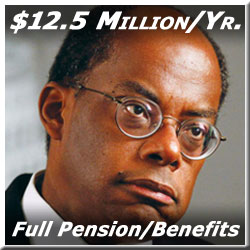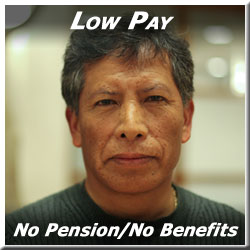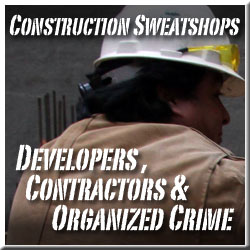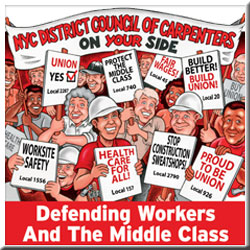Construction Sweatshop Workers
Low Pay, No Pension, No Benefits, Few Safety Protections
Construction sweatshops come in many forms: They can be ultramodern Manhattan high-rise hotels-in-the-making, small Long Island City factories, or scaffolding projects that spring up around buildings across the metropolis.
The unsafe conditions that characterize nonunion sites contrast sharply with the much safer work conditions — and higher pay — found on union job sites. So just how does a construction worker get into the union?
Union membership generally follows graduation from a New York State-sponsored apprenticeship program. The state solicits applications for that program after estimating the likely number of job openings for new carpenters. A lottery determines just who will be invited to attend the apprenticeship classes. Apprentice carpenters begin working full-time on construction sites, and every six months they attend a week of classes, during which they earn basic certifications in such areas as scaffold-making, Occupational Safety & Health, and more.
The best testimony about labor in both nonunion and union workplaces comes from the workers themselves. Here are some of their accounts:
JEREMY TAYLOR has worked in construction for six years and is currently employed as a carpenter at a high-rise hotel that nonunion workers are building in Midtown New York. "We do the same things as union workers but have to work for less," he says. He notes that he is "multitask," doing a wide range of jobs from putting together decking to driving a truck, all for $25 per hour. He gets no benefits such as health insurance or a pension.
"It's high-risk labor," he says, noting how carpenters have to work right up to the edge of still-skeletal buildings, with cranes looming overhead, materials whizzing by, and workers utilizing a variety of power tools. "The most serious injury I ever saw was when concrete was being poured, and the boom of the truck came down and pinned a guy to the floor, breaking several of his ribs." There are less-dramatic injuries every day, he adds, with workers getting hit in the eye with equipment or others having parts of fingers cut off. He counts himself lucky that he himself has never been injured.
The Guyana-born carpenter would very much like to join the union, as much to benefit his wife and four kids as himself. "It's not just a matter of money," he says: Currently, his family's only health insurance comes from a bare-bones policy that his stay-at-home spouse bought to cover herself. Even affording that is difficult when you have to pay out-of-pocket, he adds.
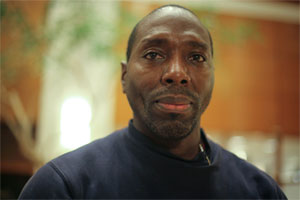
Marcus Sykes
The safety conditions and remuneration at union work sites provide quite a contrast, says MARCUS SYKES, a union member for ten years. Sykes is currently employed as a carpenter and a union steward at the Park Avenue Armory. Via union programs, he has earned a range of credentials, from a 10-hour Occupational Safety & Health certification to 32-hour training in how to erect, maintain, and break down scaffolding.
"It is the responsibility of the union steward to monitor safety," he notes, but ultimately every individual must also be involved. "I would speak to a man if, for example, I saw him failing to 'tie up' properly with a harness," he observes. Rules are now very strict. Harnesses, safety glasses, hard hats and the likes are basics on every union job.
But accidents can happen even in the best of circumstances, he says, recalling how he was present once when a crane fell on one job site and they had to shut part of the area down. "A bolt was missing — it wasn't inspected properly," he notes. "That shows that even when people are paying close attention, construction is very dangerous work."
Prior to joining the union, Sykes worked at a variety of nonunion projects, both commercial and residential. He joined when the Carpenters Union began a campaign at his job site. But not every nonunion worker knows enough to want to join up, he observes. "If you are working nonunion, you don't know about the union benefits or pay level. Most nonunion guys think that if they get $15 or $25 an hour, working off the books with no taxes withheld, that seems pretty good." What's more, many nonunion guys are fearful that if they stand up to the boss they might lose their jobs.
So what would he tell a nonunion worker about the benefits of union membership? "We are the highest paid tradespeople in the United States," he asserts. "If I encounter an ambitious nonunion person, I inform them how to go about joining up. The union's four-year apprenticeship program will help them master a great set of skills. And you don't have to pay to come to our school — just put your name on the list and come to classes when you are called." Union classes, he observes, range in duration from two nights to 12 weeks. "Certifications are what keep you competitive and in demand," he says, brandishing a wallet full of certification cards. "You should always strive to add certifications since they determine how often you get called out for work."

Brian Brady
BRIAN BRADY is also a union carpenter, having graduated from the union apprenticeship program in 1984. Over the years, he has worked on a variety of impressive projects, from the World Trade Center and buildings in the financial district to renovations at the flagship stores of Macy's and Lord & Taylor. Today, Brady is an organizer for the union.
Just south of Manhattan's Union Square, there are a large number of new buildings going up. Brady says most of the New York University and New School edifices are union projects. But many new hotels are not union. "The developers say they can only spend between $5 million and $25 million on these projects, and that that means they can't afford union labor. It's really just greed: They believe they can build these things on the cheap, and they know they have a large supply of nonunion workers to draw upon."
Brian doesn't begrudge the efforts of individual nonunion workers, but simply wants to educate them about the value of the union. He emphasizes that nonunion workers need not start from scratch as apprentices. "If they have been in construction for a number of years, they can take a test via the apprenticeship program to see just what level they have attained." And he believes that soon, there will a good deal of opportunity. "In the coming months, there are lots of big union projects coming up that may empty out the list," he says "Companies will be looking for new union members."

Charles Brown
In contrast to this vision of safer work and skill specialization, CHARLES BROWN reports nonunion work sites can be rife with mistreatment, arbitrary firings, and short pay. As a welder who was also required to erect and dismantle tower cranes, Brown was paid substandard wages of around $18 per hour for dangerous overtime labor on weekends. "I am climbing, hanging from heights with a 20-pound hammer, walking on a boom to erect a crane," he recounts. "I don't mind because I love to take a risk, I love adventures like that, but treat me fair," he says. Instead, once he spoke out about the low pay he was told not to come into work for several days. "Everybody else had work but me."
An immigrant from Trinidad, Brown learned welding in his native land. His first U.S. job was at a small ironwork company, where he started at $9 per hour.
A few weeks back, the 39-year-old welder became a first-time father. "I need to make something for me and my new daughter," he observes. "I can't continue exploiting myself — I need to get into the right channel. I would love to become a union member since I know it's the only way to get justice." But Brown, too, understands that many nonunion workers are fearful. "Most of the guys in my previous workplace are Hispanic — they have mouths to feed here and abroad," he observes.

Adrian Lucas
An increasing number of women are finding work in construction. One of these is ADRIAN LUCAS who has worked as a welder and, for the last four years, as a carpenter. Lucas says that she has not experienced either harassment or discrimination. "Some co-workers may have rolled their eyes at me, but no one has said anything negative," she explains. "They are all rather nice."
But Lucas is currently working on a nonunion site — a J.C. PENNEY outlet on Broome Street in Manhattan — where she earns $16 per hour as a framer and putting up sheetrock. Not only is this less than she would like to earn, but working conditions there are dangerous, she believes. "It is 85% dangerous," she elaborates, pointing to the risks of open shafts and questionable scaffolding. "They don't go by the legal codes. The Department of Buildings stops by and nothing happens. It shocks me that they haven't been shut down."
Lucas was born and raised in New York, but she says that perhaps half of her co-workers are foreign-born. She pays $29 a month to have a very basic medical insurance policy. And she is hoping to join the union shortly. "There are a lot of people who deserve to be in the union," she notes. "But it's hard for union members to get jobs when so many are working for very little money."
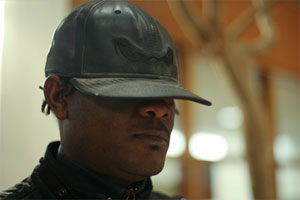
Dennis Clark
DENNIS MICHAEL CLARK is one of those foreign-born carpenters. He has worked in construction for ten years, five of those in Jamaica before coming here. While his parents also live in New York, his wife remains behind in Jamaica.
Of late, work has been catch-as-catch-can for Clark. He most recently spent a day doing brick work on a nonunion, commercial-building site on 18th Street. He's not even sure just what he will be paid for this. Before that, he worked from last November through April, doing carpentry at the World School located on Tenth Avenue. At that nonunion site, he was paid $15 per hour. He hasn't had steady work since last spring.
Clark joins others in regarding nonunion jobs as unsafe. At one site, workers could not tie up properly to scaffolding: There were no harnesses, "they just gave you a rope." On another job, he saw a co-worker electrocuted.
Carpentry is "much different in New York than in Jamaica," he observes, noting for example that here they use metal studs inside of buildings, rather than wooden ones. The difference in the work means that "I'm not a full journeyman here," he explains.
He would very much like to be represented by the union, but knows that "things are slow now." He is eager to take the union's apprenticeship classes. "It's hard out here with no benefits," he remarks.
There's no discrimination at union worksites, says union carpenter VAN CARTER. "If you can do the work, skin color and nationality don't matter," he observes. "And there are more and more women coming onto the job, too," he adds. On his most recent job, at Lincoln Hospital in the Bronx, Carter says he earned $46 per hour — a far cry from the $12.50 per hour he once earned working nonunion.
And Carter, too, emphasizes the greater safety found at union sites. "Nonunion places are more worried about getting the job done in a hurry. So they want you to work on scaffolds without guard rails, and a lot want you to work off a ladder. They don't give you no harness. Falling from scaffolding is very common. On a union job you have people like shop stewards walking around making sure things are safe; on nonunion jobs all you have is the boss rushing the work."

Damian Ramirez
That scaffolding you see outside so many New York buildings is there in part due to the work of union member DAMIAN RAMIREZ. "Most scaffolding is put up by nonunion workers," he says, recalling how in his own nonunion days he got paid as little as $10 per hour for this work. After joining the union as a laborer, he earned $36 an hour plus benefits. "Nonunion workers often aren't paid for overtime, and workers are afraid to ask for it," he notes. "They sometimes don't know what their rights are — and the companies' attitude is 'take it or leave it.' "
Ramirez was born in Puebla, Mexico, and came to the United States eleven years ago. Like others, he appreciates the union's emphasis on safety. "There's always somebody checking on you," he says, "telling you that you've got to 'tie up,' for example. He believes that scaffolding workers are subject to dangers both visible and invisible. "Sometimes we smell a lot of dust, possibly asbestos," he reports. "The Carpenters Union sends you to classes to help you know these dangers." Then, too, there was the time he was injured when still working nonunion. "It began snowing when I was putting beams in a truck. My feet slid out from under me, and I fell off the truck." Luckily, he anticipated that one beam might fall as well and strike him, so he rolled away — and the falling beam did less damage. After the incident and injury, he was told to stay at home for some days, being given time off without pay. And of course, he had no benefits. "If it had been a union job, they would continue to pay you during time off."
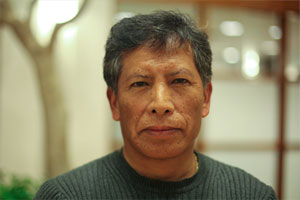
Pedro Lituma
Such construction work is a world away from the nonunion factory where PEDRO LITUMA has worked for 27 years as a cabinetmaker. His is a skilled occupation, and he is treated better than many of his co-workers. But concern for those who are spraying cabinets with solvents and paints, as well as doing other less-skilled work, has made him favor union organization. The Carpenters Union has tried repeatedly to organize the Long Island City shop — and each time management has employed a combination of threats to close the factory along with very small raises and vacation benefits to stave off organization. "We found the union by looking in the Yellow Pages," says Lituma. He intends to keep trying to win union recognition — and the union intends to keep trying as well.
Finally, JUNIOR DETERVILLE represents one who saw the light. As a nonunion worker helping to renovate JFK Airport's Radisson Hotel in 1998, he was earning $10 an hour. Then, the Carpenters Union threw up a picket line in an effort to force the employer to come to terms. For one week, Deterville and others crossed the picket line — until one day he decided to throw in his lot with the union. "It was kind of a sacrifice at the time, since the union was paying only $20 per day in strike benefits," he says. It wasn't long before the contractor came to terms with the union.
Now, Deterville is a solid supporter of the union. "I came to the USA 21 years ago from St. Lucia," he says, never imagining that he'd be as successful as he has become. Not only has his family — two boys, two girls — enjoyed union health benefits over the years, he has put enough aside to purchase a four-family building in Brooklyn. "Once I lived from paycheck to paycheck," he recalls, noting that "the union has been good to me and my family." He only wishes that other nonunion workers understood better how to find the union and become "certified union carpenters." Perhaps his account here will help to guide them.
What is the NYC District Council of Carpenters' Labor Technical College?
Interview with Director of Training Elly Spicer
Among the major benefits of membership in the Carpenters Union are the large number of apprentice and journey-level classes offered by the New York City District Council of Carpenters' Labor Technical College. These cover topics ranging from scaffolding to health-and-safety, blueprint reading, and specialized crafts such as welding and cabinetmaking. In a recent interview, Director of Training Elly Spicer described the program.
Q: How does someone sign up for the classes and is there any cost?

Elly Spicer
A: There is no cost-- the apprenticeship/journey program is paid for by members working for contractors who've signed union contracts. But you must be a union member to be eligible for the classes.
The vast majority of students are in the four-year carpenters' apprenticeship program. Classes run for a full week, from 8:30 a.m. to 3:30 p.m., and apprentices must come for two weeks over the course of a semester. New York State requires 144 hours of classroom training per year--we do 160--along with 1,300 hours of on-the-job training. When they are not in classes, apprentices are out on the job.
Q: Well, then, how does the whole process work?
A: Once every couple of years, we'll announce via the Department of Labor website and through community organizations that we are accepting candidates for apprenticeship. You must be 18 years old, legal to work in the U.S., and have a social security number and a high school diploma.
Applicants come in and fill out their name and address on a card that's kept in a locked box. Once it's apparent that there are jobs going unfilled, we have a lottery, drawing a certain number of these cards. Candidates are interviewed, and go through orientation. Once they have passed a drug test and paid their dues to the local, they are scheduled for the first available classes.
Q: Since going to classes is like a full-time job, do students receive pay during the time they're in class?
A: No, but they can apply for unemployment benefits during these periods, which again represent only two weeks out of a year.
Q: And who are the teachers?
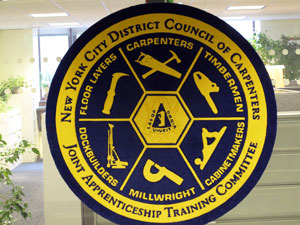
A: The teachers are all very experienced tradespeople, the vast majority having been foremen or supers in the field. They are all-around carpenters, recognized as people who have excelled at the trade and who have a dedication to training. For many, teaching represents the last segment of their careers.
Q: Are there provisions to make sure that women and people of color are well-represented?
A: New York State has allowed certain organizations "direct entry"--their candidates can skip the lottery. These groups include Nontraditional Employment for Women, the pre-apprenticeship program Construction Skills 2000s, and the union's own pre-apprenticeship program, Building Works. Our goal is to keep female enrollment at minimum of 15%, and over 50% of our students are people of color.
Q: Is it possible for those who have worked for a long while in nonunion jobs to get life credit, rather than having to start from scratch in apprenticeship classes?
A: Yes, if you can bring letters from employers, or perhaps pay stubs showing that you actually worked, you can get up to a year of skills credit. Union locals are also entitled to take in someone directly as a journeyman. If we organize a contractor, we're not going to say "you have to get rid of all your employees." No--give us a list of workers you want to retain, and we will give them a practical test to find out their level of skill.
Q: I gather that a lot of the classes have to do with safety...
A: Yes, right from the beginning there are certifications in Occupational Safety and Health and cardio-pulmonary resuscitation (CPR), along with classes in hazard awareness and first aid. And generally speaking, more fully trained workers who are aware of safety issues are good for the contractors, whose insurance and workers comp costs are reduced. You don't want somebody learning on the job how to use powder-actuated tools such as "Hilti shotguns," which shoot pins to hold metal track onto concrete, or how to operate "hi lo" construction vehicles.
Q: Do some of these classes offer college credit?
A: Yes, you may get college credit toward an Associate degree. This college program is a draw for many who started college education and had to drop out because they couldn't afford it. So they can come here, continue learning while they are working and being paid, and they can potentially finish their degrees. It's a way of saying to them: We think your education is important, and it doesn't stop at the end of your apprenticeship. You should always be educating yourself.

